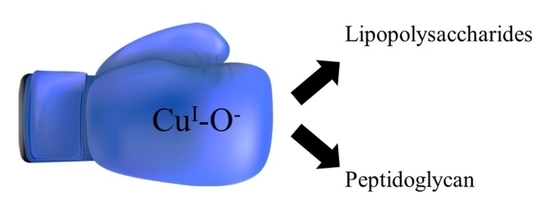A Pragmatic Perspective of the Initial Stages of the Contact Killing of Bacteria on Copper-Containing Surfaces
Abstract
:1. Introduction
2. Cell Structure
3. A Classic Contact Killing Study and Its Significance
A toilet seat, a set of tap handles and a ward entrance door push plate, all containing Cu, were installed six months before the study began; halfway through the ten-week study, they were interchanged with similar items that did not contain Cu, and their use was continued at other sites. At whichever locations they were placed, none of the ten Cu-containing sites failed the benchmark antimicrobial test of a total aerobic count of less than 5 colony-forming units/cm2; that is, even contaminated Cu surfaces were antimicrobial. These results were confirmed by several similar studies listed in [6].
4. Water Adsorption onto Solids
5. Attack on Bacteria
6. Initial Stages of Contact Killing
7. Summary and Conclusions
Funding
Institutional Review Board Statement
Informed Consent Statement
Data Availability Statement
Conflicts of Interest
References
- Sacher, E. Comment on “High-Resolution Microscopical Studies of Contact Killing Mechanisms on Copper-Based Surfaces”. ACS Appl. Mater. Interfaces 2022, 14, 16959–16960. [Google Scholar] [CrossRef] [PubMed]
- Vollmer, D.; de Pedro, M.A. Peptidoglycan Structure and Architecture. FEMS Microbiol. Rev. 2008, 32, 149–167. [Google Scholar] [CrossRef] [PubMed] [Green Version]
- Epand, R.M.; Walker, C.; Epand, R.F.; Magarvey, N.A. Molecular Mechanisms of Membrane Targeting Antibiotics. Biochem. Biophys. Acta 2016, 1858, 970–987. [Google Scholar] [CrossRef] [PubMed]
- Casey, A.L.; Adams, T.J.; Karpanen, P.A.; Cookson, B.D.; Nightingale, P.; Miruszenko, L.; Shillam, R.; Christian, P.; Slliot, T.S.J. Role of Cu in Reducing Hospital Environment Contamination. J. Hosp. Infect. 2010, 74, 72–77. [Google Scholar] [CrossRef]
- Loran, S.; Cheng, S.; Botton, G.A.; Yahia, L.H.; Yelon, A.; Sacher, E. The Physicochemical Characterization of the Cu Nanoparticle Surface, and of its Evolution on Atmospheric Exposure: Application to Antimicrobial Bandages for Wound Dressings. Appl. Surf. Sci. 2019, 473, 25–30. [Google Scholar] [CrossRef]
- Grass, G.; Rensing, C.; Solioz, M. Metallic Copper as an Antimicrobial Surface. Environ. Microbiol. 2011, 77, 1541–1547. [Google Scholar] [CrossRef] [Green Version]
- Bavand, R.; Chen, L.; França, R.; Loran, S.; Yang, D.-Q.; Yelon, A.; Zhang, G.-X.; Sacher, E. Comment on “Intensity modulation of the Shirley backgroundof the Cr3p spectra with photon energies around the Cr2p edge”. Surf. Interface Anal. 2018, 50, 683–685. [Google Scholar] [CrossRef]
- Vogler, E.A. Structure and Reactivity of Water at Biomaterial Surfaces. Adv. Coll. Interface Sci. 1998, 74, 69–117. [Google Scholar] [CrossRef]
- Xiao, C.; Shi, P.; Yan, W.; Chen, L.; Qian, L.; Kim, S.H. Thickness and Structure of Adsorbed Water Layer and Effects on Adhesion and Friction at Nanoasperity Contact. Colloids Interfaces 2019, 3, 55. [Google Scholar] [CrossRef] [Green Version]
- Freund, J.; Halbritter, J.; Hörber, J.K.H. How Dry are Dried Samples? Water Adsorption Measured by STM. Microsc. Res. Tech. 1999, 44, 327–338. [Google Scholar] [CrossRef]
- Opitz, A.; Scherge, M.; Ahmed, S.I.-U.; Schaefer, J.A. A Comparative Investigation of Thickness Measurements of Ultra-Thin Water Films by Scanning Probe Techniques. J. Appl. Phys. 2007, 101, 064310. [Google Scholar] [CrossRef]
- Kosmulski, M. Isoelectric Points and Points of Zero Charge of Metal (Hydro)Oxides: 50 Years After Parks’s Review. Adv. Colloid Interface Sci. 2016, 238, 1–61. [Google Scholar] [CrossRef]
- Limo, M.J.; Sola-Rabada, A.; Boix, E.; Thota, V.; Westcott, Z.; Puddu, V.; Perry, C.C. Interactions Between Metal Oxides and Biomolecules: From Fundamental Understanding to Applications. Chem. Rev. 2018, 118, 11118–11193. [Google Scholar] [CrossRef] [Green Version]
- Whitaker, J.R.; Feeney, R.E.; Sternberg, M.M. Chemical and Physical Modification of Proteins by the Hydroxyl Ion. CRC Crit. Rev. Food Sci. Nutr. 1983, 19, 173–212. [Google Scholar] [CrossRef]
- Schubert, J.; Radeke, C.; Fery, A.; Chanana, M. The Role of pH, Metal Ions and Their Hydroxides in Charge Reversal of Protein-coated Nanoparticles. Phys. Chem. Chem. Phys. 2019, 21, 11011–11018. [Google Scholar] [CrossRef] [Green Version]
- Brockerhoff, H. Breakdown of Phospholipids in Mild Alkaline Hydrolysis. J. Lipid Res. 1983, 4, 96–99. [Google Scholar] [CrossRef]
- Wang, L.; Hu, C.; Shao, L. The Antimicrobial Activity of Nanoparticles: Present Situation and Prospects for the Future. Int. J. Nanomed. 2017, 12, 1227–1249. [Google Scholar] [CrossRef] [Green Version]
- Gopalakrishnan, K.; Ramesh, C.; Ragunathan, V.; Thamilselvan, M. Antibacterial Activity of Cu2O Nanoparticles on E. coli Synthesized from Tridax Procumbrens Leaf Extract and Surface Coating with Polyaniline. Digest J. Nanomater. Biostruct. 2012, 7, 833–839. [Google Scholar]
- Bezza, F.A.; Tichapondwa, S.M.; Chrwa, E.M.N. Fabrication of Monodispersed Copper Oxide Nanoparticles with Potential Application as Antimicrobial Agents. Sci. Rep. 2020, 10, 16680. [Google Scholar] [CrossRef]
- Hans, M.; Erbe, A.; Mathews, S.; Chen, Y.; Solioz, M.; Mücklich, F. Role of Copper Oxides in Contact Killing of Bacteria. Langmuir 2013, 29, 16160–16166. [Google Scholar] [CrossRef]
- Abicht, H.K.; Gonskikh, Y.; Gerber, S.D.; Solioz, M. Non-Enzymic Copper Reduction by Menaquinone Enhances Copper Toxicity in Lactococcus lactis IL1403. Microbiology 2013, 159, 1190–1197. [Google Scholar] [CrossRef] [Green Version]
Publisher’s Note: MDPI stays neutral with regard to jurisdictional claims in published maps and institutional affiliations. |
© 2022 by the author. Licensee MDPI, Basel, Switzerland. This article is an open access article distributed under the terms and conditions of the Creative Commons Attribution (CC BY) license (https://creativecommons.org/licenses/by/4.0/).
Share and Cite
Sacher, E. A Pragmatic Perspective of the Initial Stages of the Contact Killing of Bacteria on Copper-Containing Surfaces. Appl. Microbiol. 2022, 2, 449-452. https://doi.org/10.3390/applmicrobiol2030033
Sacher E. A Pragmatic Perspective of the Initial Stages of the Contact Killing of Bacteria on Copper-Containing Surfaces. Applied Microbiology. 2022; 2(3):449-452. https://doi.org/10.3390/applmicrobiol2030033
Chicago/Turabian StyleSacher, Edward. 2022. "A Pragmatic Perspective of the Initial Stages of the Contact Killing of Bacteria on Copper-Containing Surfaces" Applied Microbiology 2, no. 3: 449-452. https://doi.org/10.3390/applmicrobiol2030033






